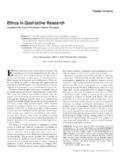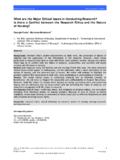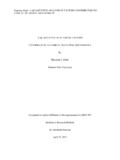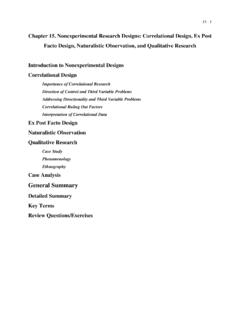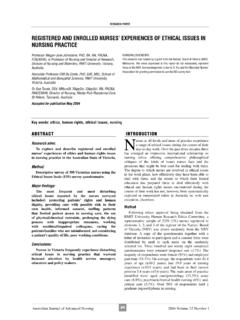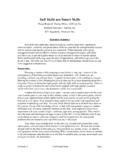Transcription of Educational Research - Nahad
1 Educational ResearchThis page intentionally left blank FOURTH EDITION John W. Creswell University of Nebraska Lincoln Planning, Conducting, and Evaluating Quantitative and qualitative Research Educational Research Boston Columbus Indianapolis New York San Francisco Upper Saddle River Amsterdam Cape Town Dubai London Madrid Milan Munich Paris Montreal Toronto Delhi Mexico City S o Paulo Sydney Hong Kong Seoul Singapore Taipei Tokyo Vice President and Editor-in-Chief: Paul A. Smith Development Editor: Christina Robb Editorial Assistant: Matthew Buchholtz Marketing Manager: Joanna Sabella Production Editor: Karen Mason Production Coordination: TexTech International Text Design and Illustrations: TexTech International Cover Design: Linda Knowles Cover Art: Chin Yuen.
2 This book was set in Garamond by TexTech. It was printed and bound by Edwards Brothers, Inc. The cover was printed by Phoenix Color Corp. Copyright 2012, 2008, 2005, 2002 by Pearson Education, Inc., 501 Boylston Street, Boston, MA 02116. All rights reserved. Manufactured in the United States of America. This publication is protected by Copyright, and permission should be obtained from the publisher prior to any prohibited reproduction, storage in a retrieval system, or transmission in any form or by any means, electronic, mechanical, photocopying, recording, or likewise. To obtain permission(s) to use material from this work, please submit a written request to Pearson Education, Inc., Permissions Department, 501 Boylston Street, Boston, MA 02116, or email Between the time website information is gathered and then published, it is not unusual for some sites to have closed.
3 Also, the transcription of URLs can result in typographical errors. The publisher would appreciate notification where these errors occur so that they may be corrected in subsequent editions. Library of Congress Cataloging-in-Publication DataCreswell, John Research : planning, conducting, and evaluating quantitative and qualitative Research / John W. Creswell. 4th ed. p. cm. Includes bibliographical references and index. ISBN-13: 978-0-13-136739-5 (alk. paper) ISBN-10: 0-13-136739-0 (alk. paper)1. Education Research Methodology. I. dc22 2010050958 10 9 8 7 6 5 4 3 2 1 ED 15 14 13 12 11 ISBN-10: 0-13-136739-0 ISBN-13: 978-0-13-136739-5 This text is dedicated to Karen, who provided caring editorial help and support through four editions of this book.
4 You have been my inspiration and thoughtful advocate throughout this project. Thanks for standing beside me. This page intentionally left blank vii Brief Contents PART I An Introduction to Educational Research 1 CHAPTER 1 The Process of Conducting Research Using Quantitative and qualitative Approaches 2 PART II The Steps in the Process of Research 57 CHAPTER 2 Identifying a Research Problem 58 CHAPTER 3 Reviewing the Literature 79 CHAPTER 4 Specifying a Purpose and Research Questions or Hypotheses 109 CHAPTER 5 Collecting Quantitative Data 140 CHAPTER 6 Analyzing and Interpreting Quantitative Data 174 CHAPTER 7 Collecting qualitative Data 204 CHAPTER 8 Analyzing and Interpreting qualitative Data 236 CHAPTER 9 Reporting and Evaluating Research 265 PART III Research Designs
5 293 CHAPTER 10 Experimental Designs 294 CHAPTER 11 Correlational Designs 337 CHAPTER 12 Survey Designs 375 CHAPTER 13 Grounded Theory Designs 422 CHAPTER 14 Ethnographic Designs 461 CHAPTER 15 Narrative Research Designs 501 CHAPTER 16 Mixed Methods Designs 534 CHAPTER 17 Action Research Designs 576 This page intentionally left blank ix21 Contents PART I An Introduction to Educational Research 1 Chapter The Process of Conducting Research Using Quantitative and qualitative Approaches 2A Definition of Research and Its Importance 3 Research Adds to Our Knowledge 4 Research Improves Practice 4 Research Informs Policy Debates 6 Several Problems with Research Today 6 The Six Steps in the Process of Research 7 Identifying a Research Problem 8 Reviewing the Literature 8 Specifying a Purpose for Research 9 Collecting Data 9 Analyzing and Interpreting the Data 10 Reporting and Evaluating Research 10 The Characteristics of Quantitative and qualitative Research in Each of the Six Steps 11 Quantitative Research Characteristics 13 qualitative Research Characteristics 16 Similarities and Differences between Quantitative and qualitative Research 19 Research Designs Associated with Quantitative and qualitative Research 20 Important Ethical Issues in Conducting Research 22 Institutional Review
6 Boards 22 Professional Associations 23 Ethical Practices throughout the Research Process 23 Some Ethical Issues in Data Collection 23 Some Ethical Issues in Data Reporting 24 Skills Needed to Design and Conduct Research 24 Solving Puzzles 25 Lengthening Your Attention Span 25 Learning to Use Library Resources 25 Writing, Editing, and More Writing 25 Key Ideas in the Chapter 26 The Definition and Importance of Educational Research 26 The Six Steps in the Process of Research 26 The Characteristics of Quantitative and qualitative Research 26 The Types of Research Designs Associated with Quantitative and qualitative Research 26 The Important Ethical Issues 27 The Skills Needed to Design and Conduct Research 27 Useful Information for Producers of Research 27 Useful Information for Consumers of Research 27 Understanding Concepts and Evaluating Research Studies 28 Sample Quantitative Study 29 Sample qualitative Study 42 PART II The
7 Steps in the Process of Research 57 Chapter Identifying a Research Problem 58 What Is a Research Problem and Why Is It Important? 59 How Does the Research Problem Differ from Other Parts of Research ? 59 Can and Should Problems Be Researched? 61 Can You Gain Access to People and Sites? 61 Can You Find Time, Locate Resources, and Use Your Skills? 61 Should the Problem Be Researched? 62 How Does the Research Problem Differ in Quantitative and qualitative Research ? 63 How Do You Write a Statement of the Problem Section? 64 The Topic 64 The Research Problem 66 Justification of the Importance of the Problem 66 Deficiencies in What We Know 69 TheAudience 70 What Are Some Strategies for Writing the Statement of the Problem Section?
8 70A Template 70 Other Writing Strategies 71 Think-Aloud About Writing a Statement of the Problem 72xCONTENTS543 Examples of Statement of the Problem Sections 72 Reexamining the Parent Involvement and the Mothers Trust in School Principals Studies 75 Key Ideas in the Chapter 76 Define a Research Problem and Explain Its Importance 76 Distinguish between a Research Problem and Other Parts of Research 76 Criteriafor Deciding Whether a Problem Can and Should Be Researched 76 The Difference between Quantitative and qualitative Research Problems 76 The Five Elements of a Statement of the Problem Section 76 Strategies Useful in Writing the Statement of the Problem Section 76 Useful Information for Producers of Research 77 Useful Information for Consumers of Research 77 Understanding Concepts and Evaluating Research Studies 77 Conducting Your Research 78 Chapter Reviewing the Literature 79 What Is a Literature Review and Why Is It Important?
9 80 How Does the Literature Review Differ for Quantitative and qualitative Studies? 80 What Are the Five Steps in Conducting a Literature Review? 81 Identify Key Terms 82 Locate Literature 82 Critically Evaluate and Select the Literature 91 Organize the Literature 92 Write a Literature Review 98 Reexamining the Parent Involvement and the Mothers Trust in Principals Studies 104 Literature Review Analysis in a Quantitative Study 104 Literature Review Analysis in a qualitative Study 104 Key Ideas in the Chapter 105 What Is a Review of the Literature and Why Is It Important? 105 The Five Steps in Conducting a Literature Review 105 Useful Information for Producers of Research 106 Useful Information for Consumers of Research 107 Understanding Concepts and Evaluating Research Studies 107 Conducting Your Research 107 Chapter Specifying a Purpose and Research Questions or Hypotheses 109 What Are Purpose Statements, Research Questions, Hypotheses, and Objectives?
10 109 The Purpose Statement 110 Research Questions 110 Hypotheses 111 Research Objectives 111 Why Are These Statements and Questions Important? 112 How Do You Design Quantitative Purpose Statements, Research Questions, and Hypotheses? 112 Specify Variables 112 The Family of Variables 114 Think-Aloud About Identifying Variables? 119 Theories and Testing of Variables 120 Writing Quantitative Purpose Statements 122 Writing Quantitative Research Questions 124 Writing Quantitative Hypotheses 125 How Do You Design qualitative Purpose Statements and Research Questions? 128 Differentiating between Quantitative and qualitative Purpose Statements and Research Questions 128 The Central Phenomenon in qualitative Research 129 Emerging Processes in qualitative Research 130 Writing qualitative Purpose Statements 131 Writing qualitative Research Questions 132 Reexamining the Parent Involvement and Mothers Trust in Principals Studies 136 Key Ideas in the Chapter 136 Distinguish among Purpose Statements, Research Questions, Hypotheses, and Objectives 136 KnowWhy These Statements and Questions Are Important 137 Write Quantitative Purpose Statements, Research Questions.
